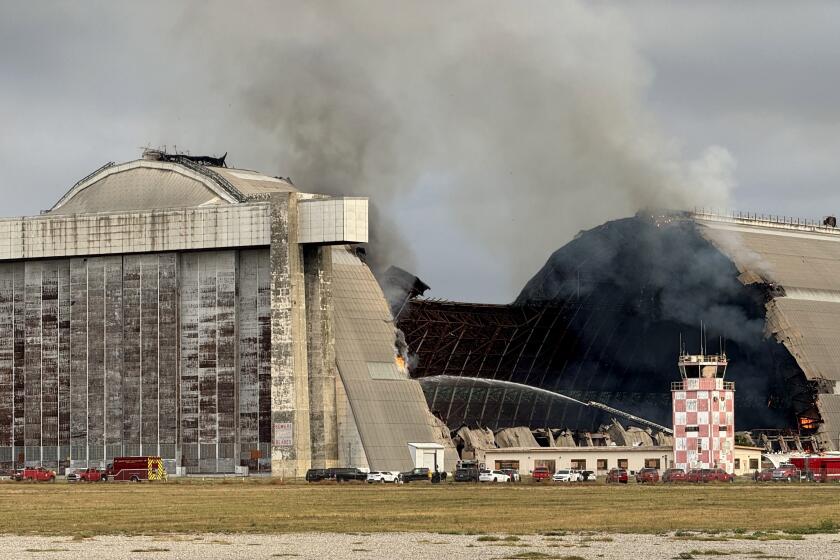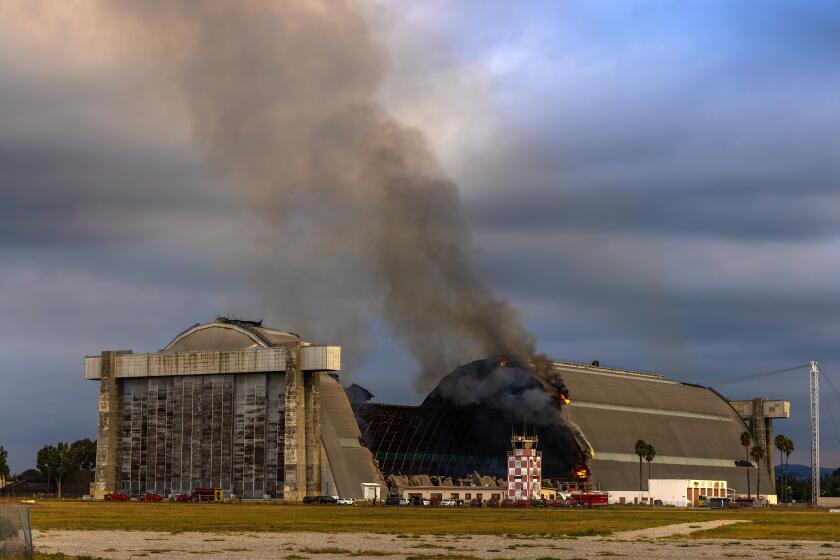Six months after the hangar fire, Tustin continues to pick up the pieces
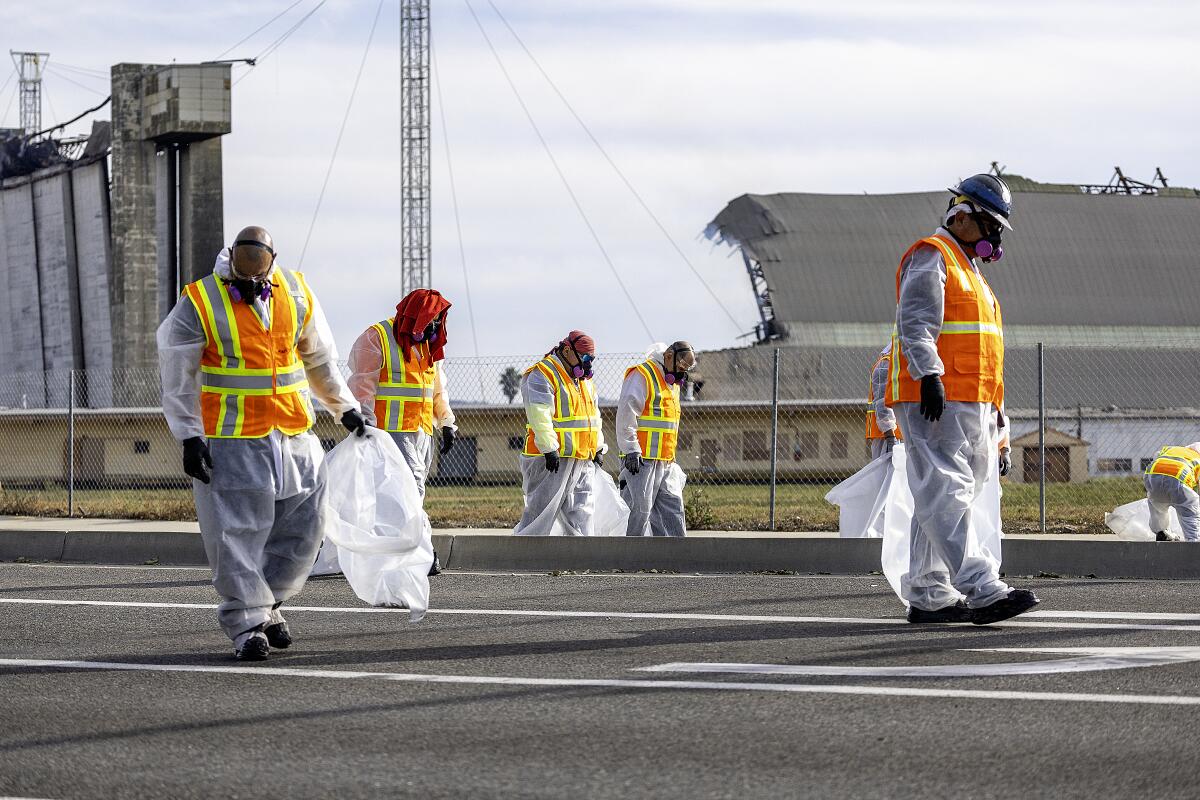
Helicopters whirling over a blimp hangar in Tustin roused Mayor Austin Lumbard from sleep just before 1 a.m. on Nov. 7.
A call to Lumbard from the city manager at the time relayed the reason why: A fire had engulfed the massive 17-story, 1,000-foot-long wooden structure half a mile from the mayor’s home.
Then, a Tustin police captain arrived to escort him to the scene.
“In those early hours, I don’t think anybody ever thought that the fire would burn for 24 days,” Lumbard said. “As it continued to burn, and as fire personnel encountered so many obstacles in trying to knock the fire down, it became apparent that the costs were going to grow exponentially.”
Six months after the fire destroyed much of the historic World War II-era hangar owned by the Navy, Tustin has contracted $88 million in recovery efforts.
A rough estimate by city analysts places the potential cost of deconstruction and cleanup at $137 million, a figure that far surpasses Tustin’s annual budget.
“We’re spending on behalf of the Navy,” Lumbard said. “They’ve committed to paying for the impacts, and we’re taking them at their word. We need them to expedite the government funding process to pay for the incursion.”
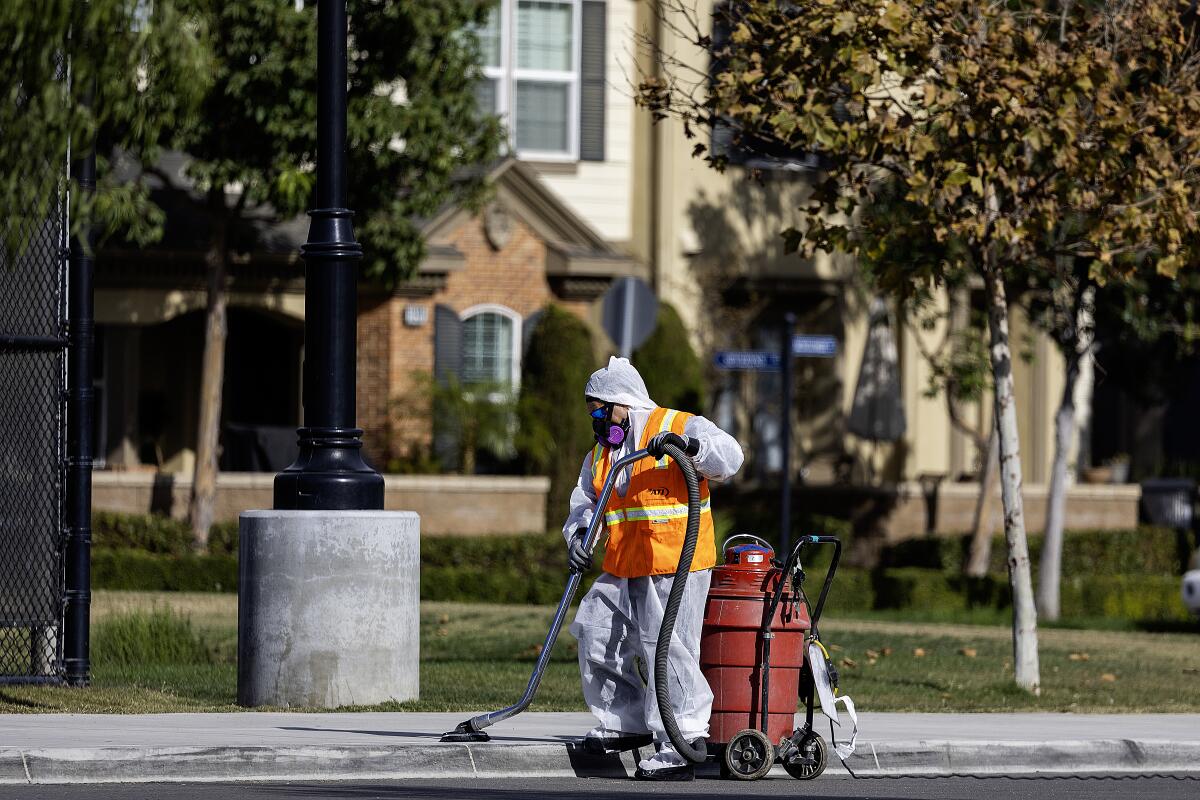
A fraction of recovery costs have gone to address pressing concerns about what spewed from the ashes and debris of the fire through a soil, air and dust study commissioned by the city.
Two days after the fire began, city officials closed nearby schools and parks. The county declared a local emergency. Public health officials urged residents to stay indoors as much as possible.
Air quality authorities tested debris samples and found up to 37% asbestos present in one of them.
In December, Orange County Health Care Agency officials said the risk to Tustin residents from the hangar fire was low and that asbestos fibers in the air played a “limited role.” That same month, the city announced the $900,000 followup study out of an abundance of caution.
All the while, law firms began investigating potential injury claims related to exposure to the fire’s fumes, though no related lawsuits have been filed against the city to date.
The Tustin blimp hangar lost to fire Tuesday was a Hollywood icon, starring in major productions including ‘Pearl Harbor,’ ‘Star Trek’ and ‘The Hindenburg.’
Brian Hitchens, a hydrologist with Geosyntec, outlined preliminary results from the city-commissioned study on May 7 during a Tustin City Council meeting.
“We found no evidence that the Navy hangar fire resulted in increased lead or asbestos within the study area,” he told council members.
Geosyntec, a consulting and engineering firm hired by the city, randomly sampled 50 homes near the hangar site and 30 homes in Irvine and Santa Ana outside of the fire’s impact area.
A collection of federal, state and local agencies reviewed and approved Geosyntec’s work plan, including the U.S. Environmental Protection Agency.
No asbestos fibers above screening levels were detected in indoor air or dust samples.
Volunteers collected three samples for lead from all homes included in the study. Only one out of 150 residential dust samples had elevated lead levels.
“There was no evidence of soot, ash or char in those dust samples,” Hitchens explained. “It does not appear to be an exceedance related to the fire.”
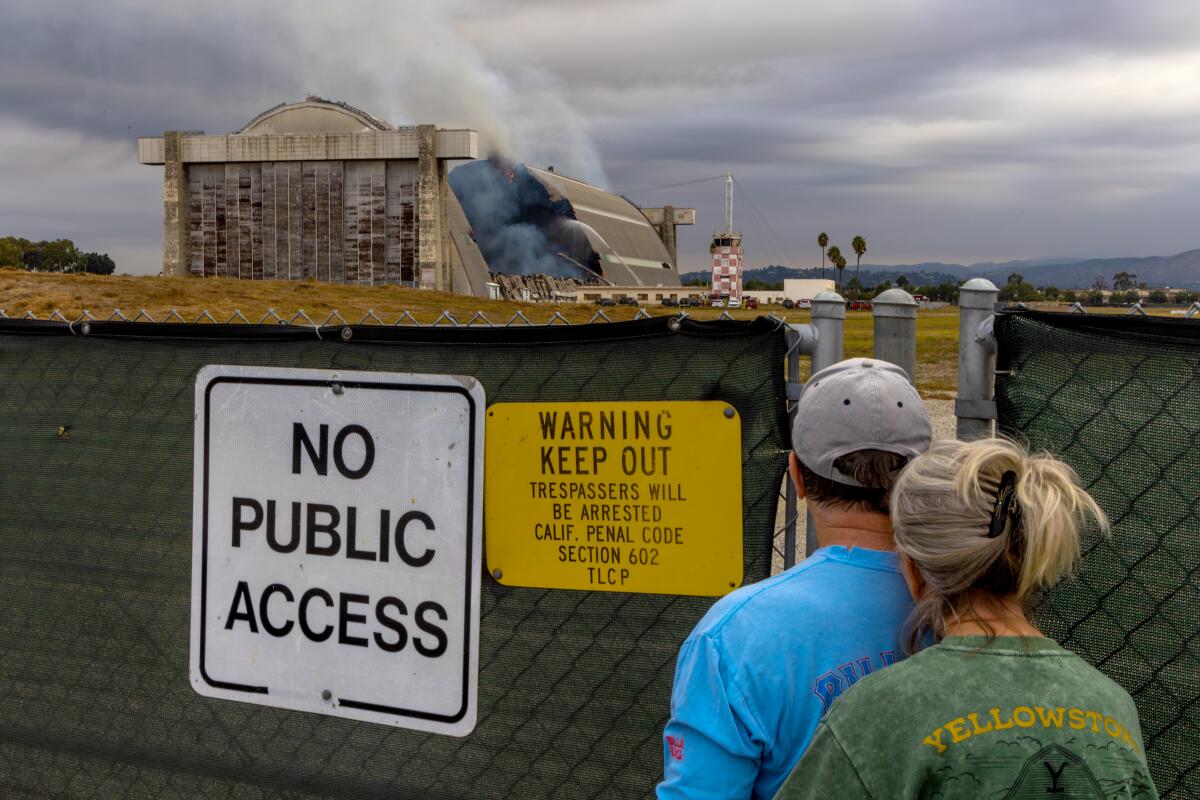
The Navy-owned hangar site was also tested, and the study found no asbestos in the ash. Twenty out of 34 debris samples contained asbestos, but the building material analyzed doesn’t crumble and release fibers.
City officials expect the full report to be released once a review of it by environmental and public health agencies is completed later this month. The study will be downloadable from the city’s website.
“We have not yet been able to review a copy of the report, but we look forward to doing so as soon as it is made available,” said Michael Penn, an attorney with the Aitken, Aitken, Cohn, a firm looking into potential claims. “Our interests remained focused on the health and safety of homeowners and others that were exposed to harmful materials caused by the fire.”
Four months after a fire engulfed the World War II-era hangar, residents and officials are looking to the federal government to help to pay for the aftermath.
Six months later, the cause of the hangar fire still remains under investigation by the Orange County Fire Authority and the Tustin Police Department.
“A lot of our lives were turned upside down because of this fire and we don’t even know how it started,” Lumbard said. “It’s frustrating. I want answers. I have faith OCFA is turning over every stone, but the fire burned for 24 days. I’m not sure what evidence was left after the fact.”
The Navy has pledged $61 million in funding, so far. A fifth amendment to a cooperative agreement between the Navy and Tustin is currently being discussed to free up more funds.
Work to clear debris from the fire’s fallout has accounted for $52 million in contracted costs alone.
In December, the Navy signed a $6-million contract with ECC Environmental to demolish remnants of the blimp hangar and clean up the rest of the site.
“The Navy’s debris removal and cleanup work plan was submitted to regulatory agencies in late April, with reviews and approval expected to take several more weeks,” said Christopher Dunne, a spokesman for the Naval Facilities Engineering Command in Washington, D.C. “Fieldwork is expected to begin this summer.”
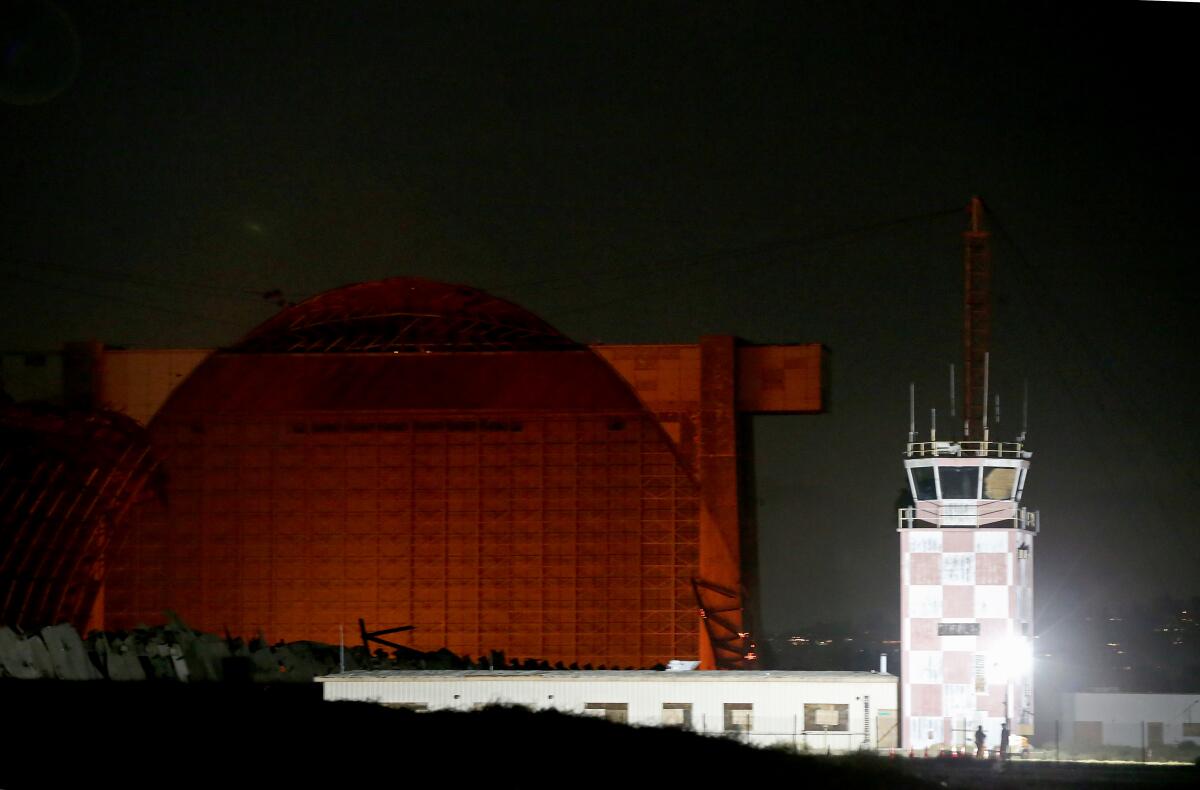
Meanwhile, a resolution by state Sen. Josh Newman (D-Fullerton) aimed at shoring up the funding for recovery efforts passed the senate with a bipartisan unanimous vote.
“Almost six months in, the fallout from the fire continues to be a source of frustration and concern within the community,” Newman said in a floor speech before the vote. “It has left this relatively small community with unprecedented fiscal burdens.”
The resolution calls on the Biden Administration and U.S. Congress to declare a formal emergency and secure $100 million in supplemental funding for the Navy. It advances to the state Assembly next.
Looking forward to the future, Lumbard hopes the Navy’s cleanup work can began as soon as possible as Tustin looks to close a chapter on the hangar fire.
Part of that process includes a south hangar at the former Marine Corps Air Station site and the question of what to do with it. The Navy owns the hangar, but Tustin leases and controls the site.
Had the fire engulfed the south hangar in November, the hardships on the city could have been far more dire.
“Tustin is taking a very hard look at the future and whether we need to deconstruct the hangar itself,” Lumbard said. “That’s a painful discussion, especially for our veteran community, but we cannot afford to have another potentially $100-million disaster occur on city-controlled property.”
All the latest on Orange County from Orange County.
Get our free TimesOC newsletter.
You may occasionally receive promotional content from the Daily Pilot.
